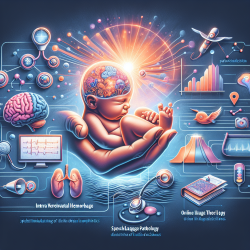Introduction
Intraventricular hemorrhage (IVH) is a severe brain injury often seen in premature infants, with limited treatment options available. The recent study titled "Photostimulation of brain lymphatics in male newborn and adult rodents for therapy of intraventricular hemorrhage" by Li et al. (2023) presents promising findings that could revolutionize the treatment of IVH through non-invasive photostimulation techniques. This blog aims to translate these findings into actionable insights for practitioners working with children, particularly those providing online therapy services through platforms like TinyEYE.
Key Findings from the Research
The study conducted by Li et al. (2023) demonstrated that transcranial photostimulation can significantly enhance the clearance of red blood cells (RBCs) from the brain's ventricular system in both newborn and adult rodents. The researchers found that photostimulation at a wavelength of 1267 nm improved the function of meningeal lymphatic vessels (MLVs), which are crucial for draining RBCs from the brain into the deep cervical lymph nodes (dcLNs). This process was shown to expedite recovery and improve neurological outcomes in rodents with IVH.
Clinical Implications for Practitioners
For practitioners working with children, especially those in school settings, the implications of these findings are profound. Here are some key takeaways and potential applications:
- Non-Invasive Treatment: Photostimulation offers a non-invasive, non-pharmacological approach to treating IVH, which could be particularly beneficial for premature infants who are already vulnerable to invasive procedures.
- Improved Outcomes: By enhancing the brain's lymphatic drainage system, photostimulation can potentially reduce the size of hematomas, improve the permeability of the blood-brain barrier (BBB), and accelerate overall recovery. This could lead to better long-term cognitive and motor outcomes for children affected by IVH.
- Integration with Online Therapy: Platforms like TinyEYE can integrate photostimulation protocols into their therapy services, providing a holistic approach to treating children with IVH. This could involve remote monitoring and guidance on the use of photostimulation devices.
Encouraging Further Research
While the findings are promising, further research is essential to validate the efficacy and safety of photostimulation in human infants. Practitioners are encouraged to stay updated with ongoing clinical trials and contribute to research efforts where possible. Collaborative research can help refine the protocols and establish standardized guidelines for the use of photostimulation in treating IVH.
Conclusion
The study by Li et al. (2023) opens up new avenues for treating intraventricular hemorrhage in newborns through non-invasive photostimulation. For practitioners dedicated to improving outcomes for children, integrating these findings into practice could significantly enhance the quality of care. By staying informed and contributing to further research, we can collectively advance the field and provide better therapeutic options for vulnerable infants.
To read the original research paper, please follow this link: Photostimulation of brain lymphatics in male newborn and adult rodents for therapy of intraventricular hemorrhage.










